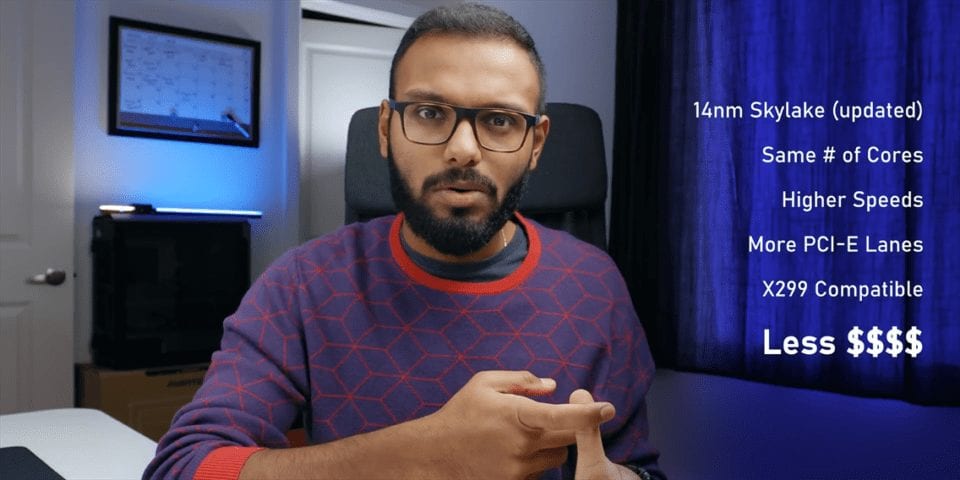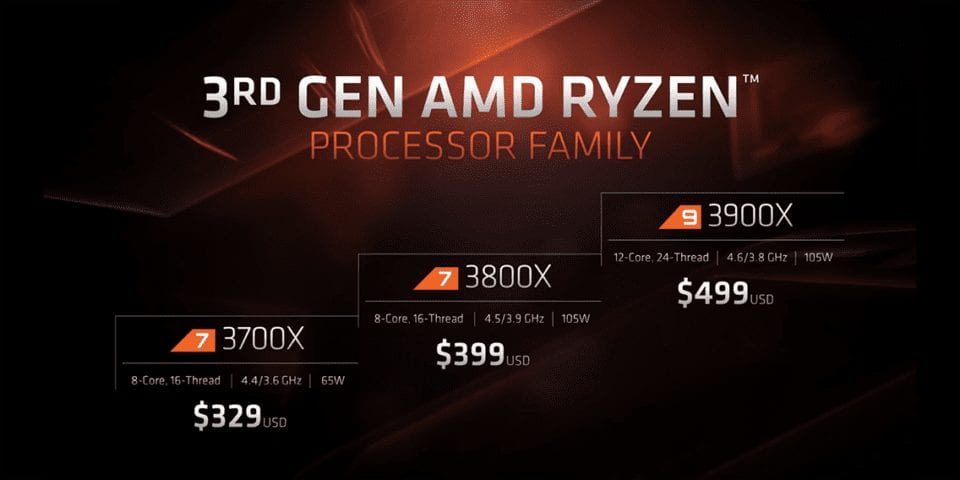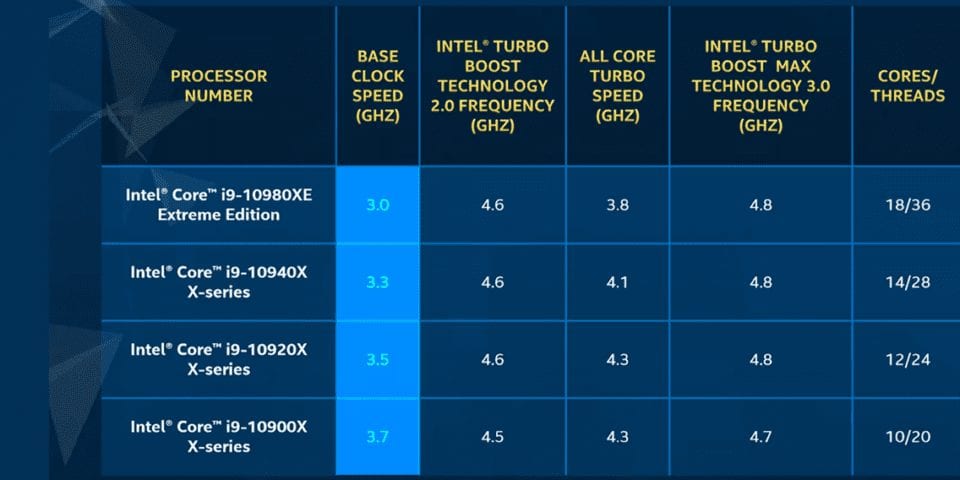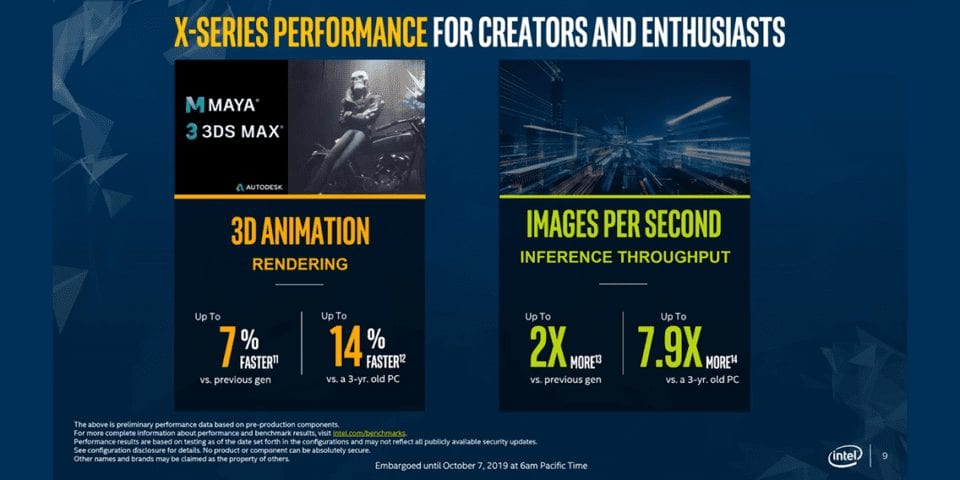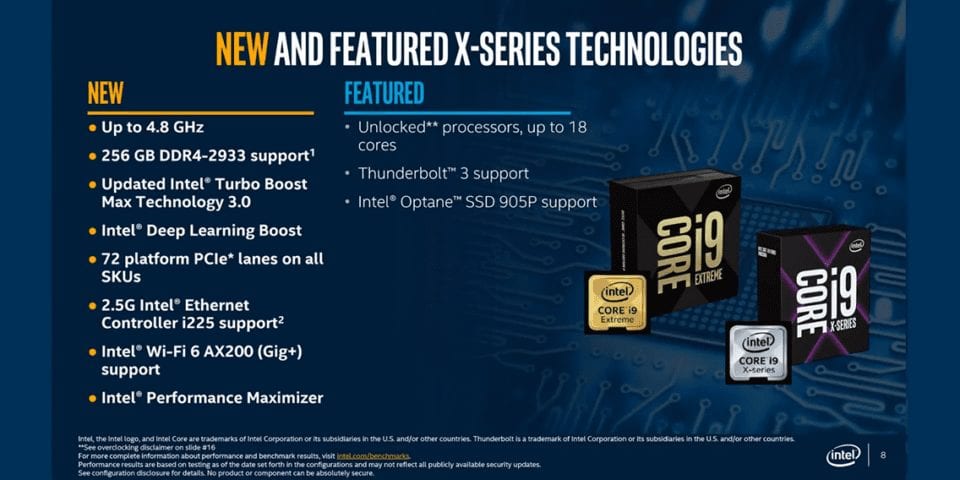Just More Of The Same? Intel Cascade Lake X EXPLAINED

Share:
As every tech YouTuber would say “Tech-tober” has officially begun, which means we are about to drown under a bunch of new products. I’m preparing my body to embrace those launches because the next few weeks are going to be pretty hectic to be honest. Let’s kick things off with a bunch of news from Intel, news that actually doesn’t have anything to do with notebooks or ultrabooks, which is good because it means that we are finally going to talk about desktop processors. Honestly, I’ve been pretty critical about Intel’s Ice Lake and Comet Lake strategy for notebooks and ultrabooks – you can read my criticism about Ice Lake here and Comet Lake here if you’re interested in learning more about that mess – but today we’re going to be talking about the new Cascade Lake X processors, their specs and their lower prices. I’m not going to be as critical in this article, but I do have mixed feelings.
More of the same, but for less
Okay, so let’s dive right into this and explain what Cascade Lake X actually is. These processors are meant to replace the i9-9000X and XE series, but they aren’t completely new either. You see they are still based off an updated 14nm Skylake architecture, have the same number of threads, higher clock speeds, and they offer more PCI-E lanes. They still use the X299 motherboards, but most importantly, they’re going to cost a lot less money. Doesn’t that sound weird to you? Intel charging less money, isn’t that more of an AMD thing? Kidding aside, come on until it’s time for a new desktop platform already. The X299 platform has been around forever, and while it does offer a ton of expansion options this thing was starting to show its age more than a year ago. Now we are seeing it again and I just think it’s ridiculous. Let’s talk about the lower prices, because what we are actually seeing is a return of Intel’s high-end desktop pricing from the Haswell-E days before it went crazy over the last few generations.
Heavy Competition
Plus, let’s be honest if Intel or even AMD could sell their high-end CPUs for $2000, they would do it. Intel didn’t want to lower their prices, no company would ever think of doing that. What really happened here is better competition from AMD forced them to do this. Since Intel isn’t able to increase core counts on 14nm some key Cascade Lake X processors will soon be competing against the $750 USD 16-core Ryzen 3950X. Sure it’s been delayed until November, but that’s when these new Intel CPUs will hit shelves too. And we can’t forget that before its price went through the roof due to demand, the $500 3900X gave the i9-9920X a pretty good run for its money, even though it costs less than half as much.
The Flagship
So what did Intel do? Well let’s actually take a look at their high-end desktop CPUs for a start. The first Skylake X processor was launched back in 2017 and it was priced at $2,000, but remember this was back at a time before Intel had competition in then desktop space. Then last year the i9-9980XE was launched for the same price, featuring the same number of threads, and running at roughly the same clock speeds. This proved that Intel was ignoring the competition, and this would quickly become a big problem for them as AMD rolled out ThreadRipper and multiple Ryzen generations. Now we have ThreadRipper 3 processors on the way and things at Intel needed to change big time. This is why we now have the Core i9-10980XE, the new Cascade Lake X processor that features the same number of threads as the previous generation, but interestingly it’s now priced at $980 USD.
The Other Models
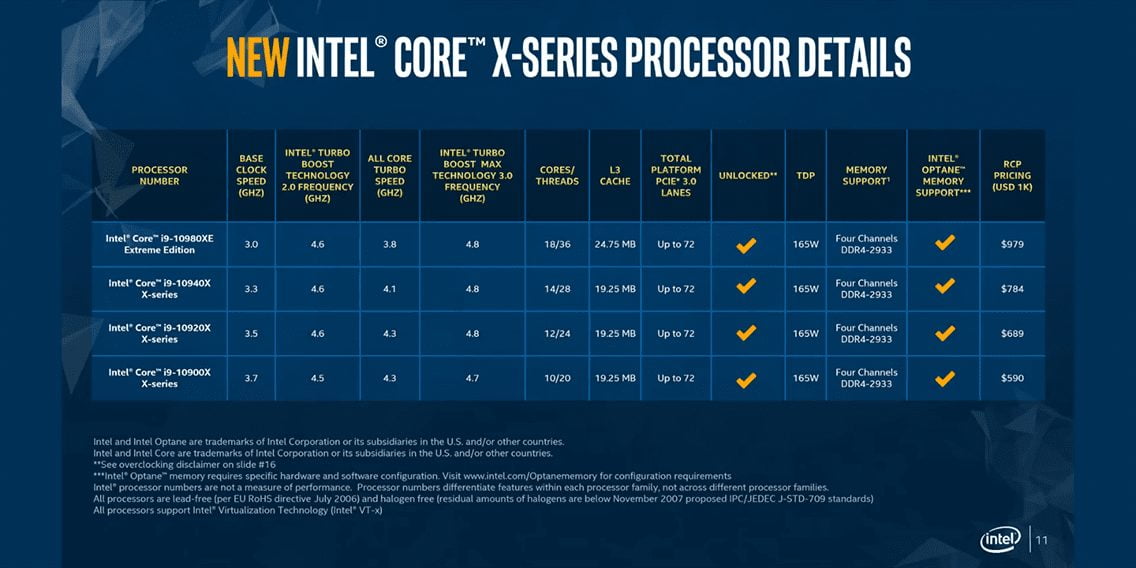
Obviously $980 is still a lot of money, but what’s really interesting is that the rest of the lineup are getting some major cuts too. You see Intel really wants to avoid the $750 Ryzen 3950X I talked about, since there’s no 16-core replacement for the i9-9960X. Instead, there’s the 18-core i9-10980XE for $980 and the 14-core i9-10940XE for $785. It will be interesting to see how these compete on a price to performance level with the Ryzen chip, but the i9-10940X is a heck of a lot less than the $1400 i9-9940X was. It also looks like the 24-thread i9-10920X might be in for a huge fight since the AMD 3900X is technically $190 less and even the ThreadRipper 2 2920X can be found for less than $500 if you look really hard. Of course, core counts are only a small part of the performance story, but the Zen architecture is really competitive. The last CPU here is the i9-10900X and it’s supposed to be a bridge product between Intel’s mainstream platform and the high-end desktop CPUs. It doesn’t really compete with anything in AMD’s current lineup either. What’s pretty obvious is the $590 price tag, which was chosen very carefully so it wouldn’t put pressure on the Core i9-9900K.
Improvements
I should also talk about these 72 PCI-E lanes that you saw in the above chart, since that is a bit of a change from before. Intel is now using the same PCI-E layout as their Xeon CPUs, so instead of having 44 lanes Cascade Lake X processors will now have 48 PCI-E Gen3 lanes. Those direct PCI-E lanes will primarily be used for GPUs, other add-in cards, and the motherboard’s M.2 storage options, and then the other 24 lanes will be coming directly from the X299 chipset.
The other change comes with clock speeds. I’m not going to go into the full details, but let’s just say that the base frequency has remained the same as the i9-9000 series, while the max Turbo Boost gets a 300MHz boost across the board. When it comes to performance gains there really isn’t all that much here even for professionals, but what did you expect from the third revision of an old architecture? I mean Cascade Lake X will only offer about 7% more rendering performance than the i9-9000 series at the most. Intel did add support for their new Deep Learning Boost algorithms, so that’s one area that gets a huge speed increase. Honestly, Cascade Lake X seems to be proof that Intel has pushed 14nm as far as possible.
Conclusion
One thing we noticed is a big change away from marketing this platform to gamers, because a lot has changed in the last few years. Both AMD and NVIDIA have pivoted their gaming GPUs away from dual and triple GPU support. Ecosystems like Z390 and X570 are usually a better choice for gamers these days. That being said while X299 is still a pretty terrible fit for gamers, it still has a lot of potential for content creators, professionals, architects, people who rely on those extra thread counts, lots of memory bandwidth, and of course expansion options.
And that pretty much covers everything there is to know about these new processors, at least until when they are finally released sometime later in November. However, I do want to add some of my own thoughts too. You see first thing is very obvious, and that’s competition is a great thing. We have to give huge props to AMD for putting pressure on Intel so that we could get these lower prices. However, lower prices can only get Intel so far because there’s some very serious concerns here too. Their flagship desktop lineup is using an old platform and an even older core architecture. It’s a power hungry architecture and that’s a problem in a market that’s becoming almost as concerned about efficiency as they are about rendering times. Cascade Lake X looks like another dead-end too, and that’s because it’s a refresh of a refresh, which makes me wonder if Intel could have just lowered the prices on existing i9-9000 series processors and then focus on next-gen architecture. However, I guess for existing X299 users this could be good news because it’s simply a drop-in upgrade. But for everyone else, it’s pretty impossible to recommend anyone to go out and buy a brand new Cascade Lake X system right now. That’s it for me, no ranting or raging in this video. In fact, I really wished Intel did this a long time ago, but I want to know your thoughts about this. Do you think it’s too late? In fact, are the new prices kind of attractive enough for you to make the switch over to Cascade Lake X? For gamers obviously not, because it’s a pretty terrible choice. I have mixed feelings, but I really want to know our thoughts about this in the comments.

